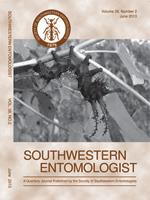Sand flies (Diptera: Psychodidae: Phlebotominae) are the main vectors of human leishmaniases worldwide. In the tropical forests of the New World, sand flies use large trees as resting, mating, and blood-feeding aggregation ecotopes. On the Peninsula of Yucatan, localized cutaneous leishmaniasis is endemic, and in recent years, progress has been made to identify the putative vectors. But, nothing is known about the natural resting sites of sand flies. The objective of this study was to use aspiration to collect sand flies in different resting micro-habitats mainly on tree trunks and other natural crevices. Sand flies also were collected using funnel traps in mammal burrows. At resting habitats, we collected 95 adult sand flies of nine species, with Lutzomyia trinidadensis (Newstead 1922) most common. Sixty-eight specimens of eight species were collected in funnel traps, with Lutzomyia deleoni (Fairchild & Hertig 1947) most abundant.
How to translate text using browser tools
1 June 2013
Adult Sand Fly Species from Diurnal Resting Sites on the Peninsula of Yucatan, México
Ana Celia Montes de Oca-Aguilar,
David Moo-Llanes,
Eduardo A. Rebollar-Téllez
ACCESS THE FULL ARTICLE

Southwestern Entomologist
Vol. 38 • No. 2
June 2013
Vol. 38 • No. 2
June 2013




